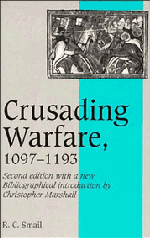Book contents
- Frontmatter
- Contents
- List of plates
- List of maps
- List of plans
- Preface (1954)
- List of abbreviations
- Bibliographical introduction (1994)
- I The historians of crusading warfare
- II Warfare and policy in Latin Syria
- III Franks, Armenians, and Syrians
- IV The Muslim armies
- V The Latin armies
- VI The Latin field army in action
- VII The Crusaders' castles
- Bibliography
- Bibliography to the second edition
- Index
- Plate section
- Frontmatter
- Contents
- List of plates
- List of maps
- List of plans
- Preface (1954)
- List of abbreviations
- Bibliographical introduction (1994)
- I The historians of crusading warfare
- II Warfare and policy in Latin Syria
- III Franks, Armenians, and Syrians
- IV The Muslim armies
- V The Latin armies
- VI The Latin field army in action
- VII The Crusaders' castles
- Bibliography
- Bibliography to the second edition
- Index
- Plate section
Summary
RECRUITMENT
During the twelfth century the armies organized by the rulers of western Europe were based on the service owed by feudal tenants of the military class and, in an emergency, on the old public obligation of every free man to serve when required. The forces raised by either means were defective for a number of reasons which will be discussed later, and it was found expedient to supplement or to replace them in part by paid troops. All three sources of recruitment, feudal host, arrière ban, and mercenaries, were used in Latin Syria, and to these were added groups of pilgrims and the increasingly important contingents of the military Orders.
La Monte has rightly said that ‘the knights who owed service for fiefs—either in land or money—formed the backbone of the army of the Latin kingdom’. The original crusaders brought with them from Europe feudal institutions; therefore those laymen to whom land was granted by the ruler held it on condition of rendering him certain services, of which one was to appear in arms at the appointed time and place to follow the lord on campaign. If the fief owed the service of more than one knight, the tenant took to the muster the number at which his lands had been assessed.
- Type
- Chapter
- Information
- Crusading Warfare, 1097–1193 , pp. 88 - 137Publisher: Cambridge University PressPrint publication year: 1994

